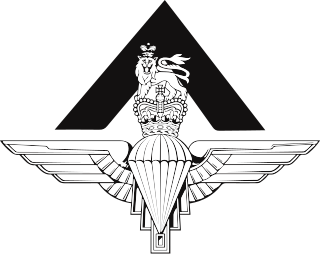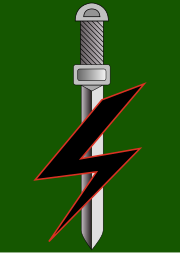
Operation Anaconda or the Battle of Shah-i-Kot was a military operation that took place in early March 2002 as part of the War in Afghanistan. CIA paramilitary officers, working with their allies, attempted to destroy al-Qaeda and Taliban forces. The operation took place in the Shah-i-Kot Valley and Arma Mountains southeast of Zormat. This operation was the first large-scale battle in the post-2001 War in Afghanistan since the Battle of Tora Bora in December 2001. This was the first operation in the Afghanistan theater to involve a large number of U.S. forces participating in direct combat activities.

The Special Air Service (SAS) is a special forces unit of the British Army. It was founded as a regiment in 1941 by David Stirling, and in 1950 it was reconstituted as a corps. The unit specialises in a number of roles including counter-terrorism, hostage rescue, direct action and special reconnaissance. Much of the information about the SAS is highly classified, and the unit is not commented on by either the British government or the Ministry of Defence due to the secrecy and sensitivity of its operations.

The Special Boat Service (SBS) is the special forces unit of the United Kingdom's Royal Navy. The SBS can trace its origins back to the Second World War when the Army Special Boat Section was formed in 1940. After the Second World War, the Royal Navy formed special forces with several name changes—Special Boat Company was adopted in 1951 and re-designated as the Special Boat Squadron in 1974—until on 28 July 1987 when the unit was renamed as the Special Boat Service after assuming responsibility for maritime counter-terrorism. Most of the operations conducted by the SBS are highly classified, and are rarely commented on by the British government or the Ministry of Defence, owing to their sensitive nature.

The Special Air Service Regiment, officially abbreviated SASR though commonly known as the SAS, is a special forces unit of the Australian Army. Formed in 1957 as a company, it was modelled on the British SAS with which it shares the motto, "Who Dares Wins". Expanded to a regiment in August 1964, it is based at Campbell Barracks, in Swanbourne, a suburb of Perth, Western Australia, and is a direct command unit of the Special Operations Command.

The 160th Special Operations Aviation Regiment (Airborne), abbreviated as 160th SOAR (A), is a special operations force of the United States Army that provides helicopter aviation support for special operations forces. Its missions have included attack, assault, and reconnaissance, and these missions are usually conducted at night, at high speeds, low altitudes, and on short notice.

The Home Army Silent Unseen Paratroopers GROM Military Unit, simply known as the GROM Military Unit, is a Polish special forces unit and forms part of the Special Troops Command of the Polish Armed Forces. It is believed to consist of around 250 operatives plus support personnel. GROM is considered to be the most elite unit in the Polish Armed Forces.

Task Force 20 is a temporary combat force designation that has been used several times and may still be used by separate parts of the United States armed forces. The longer-established iteration was a part of the United States Second Fleet in the Atlantic from after the Second World War. This was part of the formal United States Military Communications-Electronic Board system.

The Special Reconnaissance Regiment (SRR) is a tier 1 special reconnaissance unit of the British Army. It was established on 6 April 2005 and is part of the United Kingdom Special Forces (UKSF).

16 Air Assault Brigade Combat Team, known simply as 16 Air Assault Brigade from 1999 – 2021, is a formation of the British Army predominantly based in Colchester, Essex. It makes up the Air Assault Task Force, a battlegroup held at high readiness, and is the only brigade in the British Army focused on operating via parachute, helicopter and air-landing.

The Pathfinder Platoon is a pathfinder unit of the British Army, and an integral part of 16 Air Assault Brigade. The Pathfinder Platoon acts as the brigade's advance force and reconnaissance force. Its role includes locating and marking drop zones and helicopter landing zones for air landing operations. Once the main force has landed, the platoon provides tactical intelligence and offensive action roles for the brigade.
The history of the British Army's Special Air Service (SAS) regiment of the British Army begins with its formation during the Western Desert Campaign of the Second World War, and continues to the present day. It includes its early operations in North Africa, the Greek Islands, and the Invasion of Italy. The Special Air Service then returned to the United Kingdom and was formed into a brigade with two British, two French and one Belgian regiment, and went on to conduct operations in France, Italy again, the Low Countries and finally into Germany.

Following the terrorist attacks of September 11, 2001, several nations took on Al-Qaeda and the Taliban during Operation Enduring Freedom (OEF) in Afghanistan. OEF was the initial combat operations starting on 7 October 2001, in the wake of the 11 September attacks on the United States, and during 2002 and 2003.

The Joint Special Operations Command Task Force which fought in the Iraq War was a joint U.S. and British special operations temporary grouping assembled from different units. It has been described as a "hunter-killer team" with its core made up of the United States Army's 1st Special Forces Operational Detachment-Delta and the 75th Ranger Regiment, as well as the United States Naval Special Warfare Development Group and members of the United States Air Force's 24th Special Tactics Squadron, all under Joint Special Operations Command (JSOC) and elements from the United Kingdom Special Forces, including the Special Air Service, Special Boat Service (SBS), Special Reconnaissance Regiment (SRR), 18 (UKSF) Signal Regiment and the Special Forces Support Group (SFSG). The task force was reported to be responsible for the cross border raid into Syria from Iraq in October 2008 that resulted in eight deaths including Abu Ghadiya, along with several US operations in the Horn of Africa targeting al-Qaeda.

Operation Rhino was a raid led by the United States Army's 75th Ranger Regiment and, who were led by Colonel Joseph Votel, and other SOCOM units on several Taliban targets in and around Kandahar, Afghanistan during the invasion of Afghanistan at the start of the War in Afghanistan. The operation was motivated by a desire for the White House and Tommy Franks to capture video footage of special forces parachuting deep into enemy territory. Intelligence reports at the time indicated that the targeted airfield was empty, leading them to believe that the Rangers would face no resistance from the Taliban. The operation has faced subsequent criticism for its focus on media portrayal rather than solely military objectives.

The 2nd Commando Regiment is a special forces unit of the Australian Army and is part of Special Operations Command. The regiment was established on 19 June 2009 when the 4th Battalion RAR (Commando) was renamed. It is based at Holsworthy, New South Wales. The 2nd Commando Regiment trains and has served with coalition special forces units, and is highly regarded by these units. The regiment has been involved in operations in East Timor, Iraq and Afghanistan, where it was used in a direct action warfighting role. It has also been involved in domestic security operations including the 2006 Commonwealth Games and the 2014 G20 Leaders Summit. The regiment is the Command's capability lead for strike and recovery.

Special forces or special operations forces (SOF) are military units trained to conduct special operations. NATO has defined special operations as "military activities conducted by specially designated, organized, selected, trained and equipped forces using unconventional techniques and modes of employment".
The following lists events that happened during 2006 in Afghanistan.

The 75th Ranger Regiment's Regimental Reconnaissance Company is an elite special operations force that has been a member of Joint Special Operations Command (JSOC) since 2005. The unit is believed to have become part of JSOC due to its extensive training and unique capabilities to conduct special reconnaissance and close target reconnaissance (CTR) operations, and advanced force operations (AFO).
Operation Trent was an operation by Special Air Service (SAS) elements of the British Army, the largest known post-WWII operation in SAS history. Tony Blair had requested that the SAS be allowed an operation. The operation was carried out by members of a regimental task group, made up of a tactical HQ, members of A Squadron and G Squadron of the 22nd Special Air Service Regiment, supported by United States (US) forces, on an al-Qaeda-linked opium plant during the 2001 invasion of Afghanistan at the start of Operation Enduring Freedom – Afghanistan (OEF-A).



















